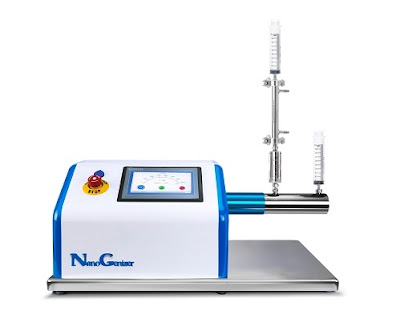How to choose a high pressure homogenizer for your applications?
High-pressure
homogenizers play a pivotal role in
various domains, including scientific research, pharmaceutical manufacturing,
cosmetics, and food processing. Opting for an appropriate high-pressure
homogenizer is crucial to ensure optimal experimental outcomes and resource
efficiency. Here are several key factors to consider when selecting the most
suitable high-pressure homogenizer:

Genizer High Pressure Microfluidic Homogenizers
1. Homogenization
Pressure: Maximizing Performance by Optimizing Pressure
Increasing
pressure allows for finer particle size reduction, enabling efficient
processing. Higher pressures accommodate a broader range of materials for
effective homogenization. For example, certain liquid emulsions require a
minimum pressure of 15,000 psi to achieve sub-100nm homogenization, while
achieving nanoscale homogenization for pharmaceuticals, foods, and suspensions
with solid particles typically demands pressures exceeding 26,000 psi.
2. Minimal
Sample Volume: Enhancing Efficiency through Material Conservation
Minimizing
sample volume helps conserve expensive raw materials, especially considering
the high cost of specific pharmaceutical ingredients (several thousand dollars
per gram). Since experiments often involve multiple iterations, larger minimum
sample volumes lead to significant material waste.
3. Processing
Effectiveness: Achieving Nano-Level Precision and Uniform Particle
Size Distribution Desirable outcomes involve
attaining nanoscale particle size and ensuring uniform particle size
distribution. To address this, it is advisable to acquire a high-pressure
homogenizer equipped with a nano-level filtration extruder device, preferably
an inline extruder, to enhance processing effectiveness.
4. Cleaning
and Sterilization: Optimizing Maintenance and Sanitization
Some
high-pressure homogenizers offer convenient cleaning and sterilization
procedures. Prioritizing models that facilitate online cleaning and
sterilization is recommended.
5. Additional
Considerations: Noise, Safety, and Reputation
Evaluate
factors such as noise levels, safety features, and the reputation of the
homogenizer. Analyzing customer lists can provide insights into the popularity
and quality of a particular device.
6. Manufacturer
Validation:
Customer References and Supporting Evidence Request a
customer
reference list from homogenizer manufacturers to assess customer satisfaction.
Additionally, inquire about relevant research papers and achievements to
further evaluate the equipment's credibility.
By thoroughly considering these factors, potential users can make well-informed comparisons and select the most suitable high-pressure homogenizer based on their specific requirements.


Comments
Post a Comment